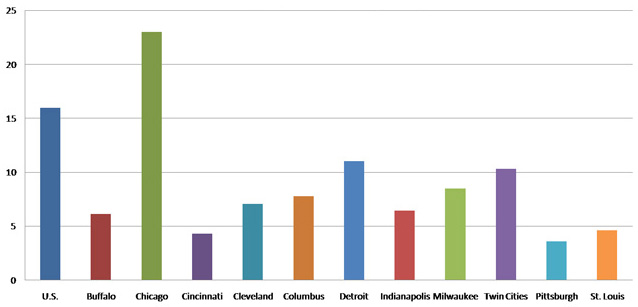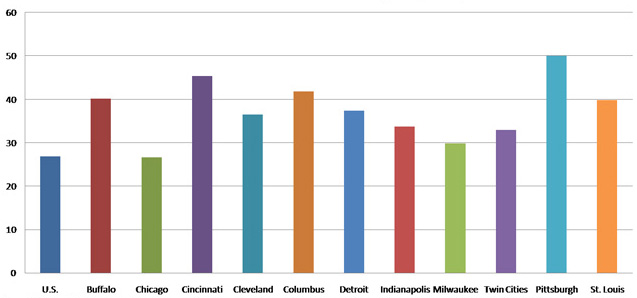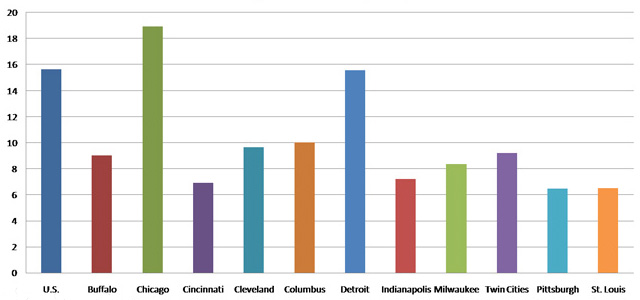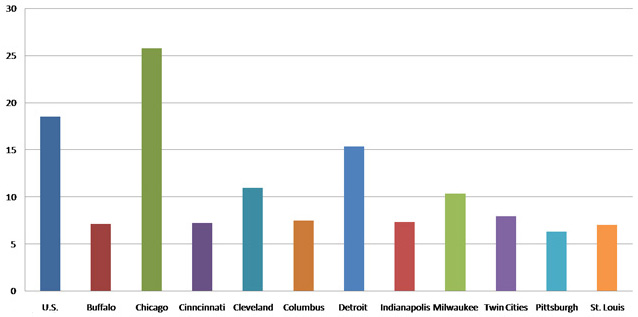Foreign Born, Educational Attainment, and Entrepreneurship
Attracting immigrants to the Midwest may be an especially lucrative objective from a regional economic development standpoint. As discussed in previous blog entries, the growth performance of metropolitan regions has been strongly linked with the educational attainment of its work force, especially college level attainment.
Educational attainment of the immigrant population in the U.S. tends to be skewed toward the high end (though it is also bifurcated—skewing toward the lower end as well). The high educational attainment of immigrants owes much to the top-notch university system found in both the Midwest and the nation, which brings many of the world’s brightest to our doors. Afterward, our market-based economy provides ample opportunities and rewards to talent, hard work, and new ideas of immigrant workers and entrepreneurs.
So far, even as the nation has experienced an upswing in immigration, the foreign born population in the Midwest lags well behind that of the nation. As the chart below suggests, the region’s large metropolitan areas host a much smaller share of foreign born, with the exception of Chicago.
1. Percent foreign born in large metro areas (2007)

A closer look below reveals that the Chicago metropolitan area has attracted both the highly educated and the less educated. The share of Chicago’s foreign born who hold a college degree is below the U.S. average. In contrast, in the remaining metropolitan areas of the Midwest, the foreign born population includes a greater share holding at least a bachelor’s degree in 2007. According to sample data from the U.S. Census Bureau, an incredible 50 percent of Pittsburgh’s working age population who were foreign born hold at least bachelor’s degree. Detroit, Cincinnati, St. Louis, and Columbus are not far behind.
2. Percent foreign born in large metro areas with at least a Bachelor's degree (2007)

Overall, however, the foreign born tend to lift Chicago’s average college attainment due to the city’s high overall propensity to attract immigrants. The Detroit area also rates highly in this regard, coming close to the national average.
3. Percent of Bachelor's degree or higher who are foreign born per large metro area (2007)

Metropolitan areas in the region may also prize the foreign born for their tendency to start new businesses. The foreign born are, on average, business owners and self-employed at about the same rate as native born, though their experiences and behaviors are quite varied. In a recent study, Maude Toussaint-Comeau finds that self-employment of immigrants varies by country of origin and by differences in personal and human capital characteristics. Immigrant-owned small businesses often contribute importantly to urban revitalization and community development.
Many more of the (immigrant) college educated concentrate their studies in technical and scientific fields than their native-born counterparts. A report estimates that in 2005, 41 percent of science PhD workers in computer, mathematical, architectural, engineering, and science occupations were foreign born. As a result, many fast-growing scientific and technical firms in IT and software have been founded by foreign born (and often U.S. educated) entrepreneurs. Another study estimated that between 1995 and 2005, 52.4 percent of the engineering and technology start-ups in Silicon Valley had one or more foreign born key founders. For our region’s foundering metropolitan economies, such firms would be truly welcome.
Our reading of the same data source above shows that entrepreneurship of the foreign born in the region’s metropolitan areas lies close to national averages. This is true of both college-educated foreign born and overall foreign born. Again, these tendencies vary across metropolitan areas.
However, the overall paucity of foreign born in the region tends to depress their importance as entrepreneurs. As the chart below suggests, again only Chicago manages to climb above the national average in this regard. The Detroit metropolitan area comes in a respectable second place.
4. Percent foreign born of area entrepreneurs

Competition in attracting technical and educated immigrants can be fierce. At a time when skilled and educated workers are most in demand in the U.S., our immigration policy focuses heavily on family re-unification rather than criteria related to occupation or skill. And, to the extent that we do allow immigration based on applicants’ job skills, we cap such visas at levels far below what employers require. In the past two years, the quota for H-1B (skill-based) visas was met quite quickly. For fiscal year 2007, the H-1B cap was met two months after the application process opened, and for fiscal 2008, the cap was met in just under one day.
Metropolitan areas in the region differ in their overt recruitment of the foreign born. One way involves enhancing the process of assimilation into the fabric of the area for recent immigrants and foreign born residents. Pittsburgh has created the Welcome Center for Immigrants and Internationals to create a welcoming environment and to provide necessary resources and information, such as advice for small business owners and career counseling services. Indianapolis organized the International Center of Indianapolis to provide relocation and training services to both attract and retain well-educated immigrants. Indianapolis, too, has developed a Welcoming Center that connects recent immigrants with well-established immigrants to facilitate community integration. In the Chicago area, the Chicago Council on Global Affairs organizes events, speakers, and task forces to raise international awareness and to expand Chicago’s perception as a top tier global city. One such program in the past included a Mexican American Task Force that provided recommendations to businesses, governments, and other interested parties of ways to utilize the strong Mexican community as an economic asset.
Metropolitan areas have also taken to outwardly promoting their international diversity and available opportunities. Many cities participate in “Sister Cities” programs to build relationships with foreign cities to increase their international profile and potentially attract foreign investment, as well as visitors. Just to list a few: Chicago has 27 sister cities spread out across the world, while Detroit has 7, Columbus 8, St. Louis 14, and Milwaukee 5. Additionally, metropolitan areas promote their diversity and opportunities through cultural festivals and events. For example, Pittsburgh held “Global Pittsburgh Celebration,” a month-long celebration that worked to raise awareness about Pittsburgh’s global assets and technology, as well as showcasing the abundant opportunities for foreign-born entrepreneurship and innovation in the area.








